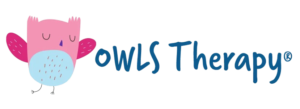Plastic Easter eggs…probably one of my most used therapy tools. And since it is finally spring, Easter eggs are easy to find and your child will probably have at least a dozen after the Easter weekend. So the question…what should you do with them? You could box them up and not think about them till next Easter or you can leave them out and reap the benefits that these little plastic ovals contain!
Easter eggs are great just to get kids moving. I use eggs all the time in therapy (I’m talking in December we will be having Easter egg hunts), especially for my kids that don’t like sitting still. I can still get the goals I want to work on in therapy targeted and that child gets to move. Win-win! So how can you target speech and language goals with plastic eggs?
1. Following directions: I like to hide the eggs around the room (where they are not visible at all) and then give the child directions based on their goals…vocabulary, prepositions, multi-step directions…can all be targeted with Easter eggs. For example, “After you do 5 bunny hops, look under the thing you sit on.” In this one direction, we targeted multiple steps (hoping like a bunny and looking under something), counting (only do 5 hops, not 4, not 6!), beginning inferencing/vocabulary development by using the cue of what does one sit on versus saying “chair,” conjunctions with the word “after,” and lastly, prepositions with the word “under.” Now, this direction could be too much for some children, but as you can see, it would be easy to take away parts or add even more if needed!
2. Articulation: Depending on how much time you have to prepare, you can either cut out pictures of words that have the target sound in them. Or if you are low on time, just writing a word on a piece of paper works great too! I like to add one egg with a special treat or a free turn where they don’t have to say any words. You can also flip this one around and put different numbers inside the eggs and this is the number of times they have to say their target word. They found the egg that has the number 12 inside, they have to say their target word 12 times! Talk about trials galore! Especially if you put down big numbers! I like to ask the child what numbers we should write so when they don’t like the 25 one, they can’t blame you!
3. Describing: For this goal, I like to put various pictures targeting nouns, verbs, or feelings. When the child finds an egg, they have to describe the picture without using the word of what it actually is. For example, if it was a picture of a lemon, they could say something like it is yellow, sour, a fruit, grows on a tree. Since you will already know what the objects all were beforehand, I like to require that at least 4 different cues are provided. For example, if it was a lemon and a child gave cues of yellow, fruit, and grows a tree. I would say “banana.” This helps the child use the descriptor that is specific to that item. You can also flip this one around where you have to describe the picture to the child and they have to guess what you are talking about!
4. Sight words: If you child is working on sight words, this can be a fun way to spice up flash cards! Write the sight word on a slip of paper and have the child go find eggs! Flash cards don’t have to be tedious!
5. Word groups: If your child is working on reading various word groups, eggs can be a quick way to target them. This does require you to write on the egg so if you wanted to use them again next year, this might not be the activity for you. On the top half of the egg, write the word group (ex. -at, -it, -ag, -ack, -ick, etc). On the bottom half, right the first letter of that goes with that word group. If you happen to make a word that doesn’t exist, that is okay! Ask the child when they read it if that is a real word or not! This is a good skill to develop as we want to make sure they are actually paying attention to what they are reading! My only hint, make sure it doesn’t make a word that you DON’T want them reading!!
About the Author
Janene Besch
Director/Speech-Language Pathologist
Janene Besch, née Martin, holds a Master’s degree in Speech Language and Hearing Sciences from San Diego State University and a Bachelor’s degree in Psychology from the University of California at San Diego. Janene is a member of the American Academy of Private Practice in Speech Pathology
Read more >













Is your preschooler having difficulty with rhyming and learning letter sounds? Is your kindergartener getting frustrated while learning to read? It may be time to consult the literacy experts and dive into a discussion about dyslexia!
Read More →